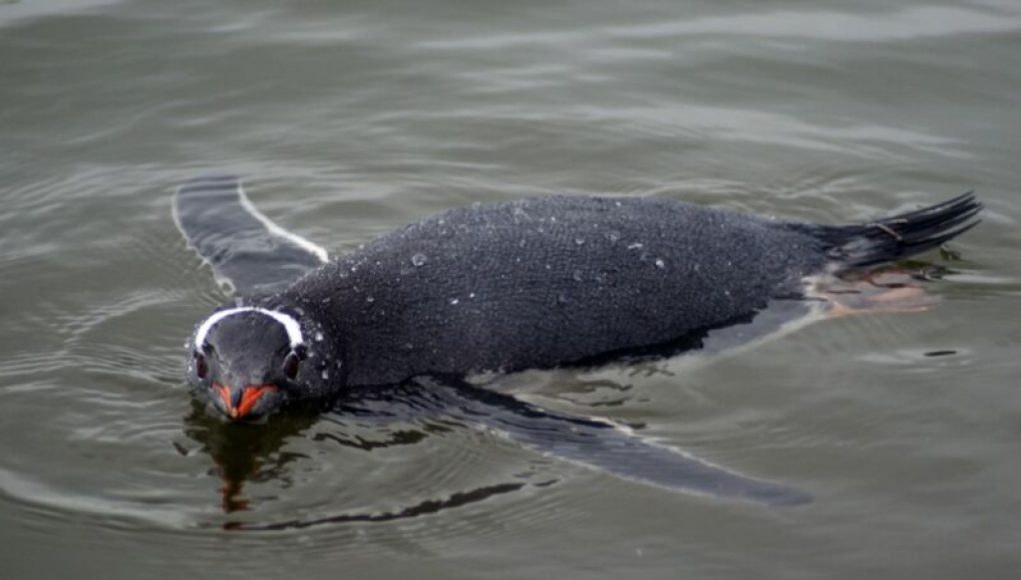Gentoo penguins are not only fascinating creatures but also the world’s fastest swimming birds, reaching incredible speeds of up to 36 km/h (about 22 mph) underwater. Their wings, which have evolved into flippers, are perfectly designed for navigating through water, although they are not very useful for flying in the air. Recently, physicists have used computational modeling to study the hydrodynamics of penguin wings, providing us with valuable insights into the forces and flows created by these wings underwater. In a recent paper published in the journal Physics of Fluids, they discovered that the penguin’s ability to adjust the angle of its wings while swimming is the key factor in generating thrust.
“Penguins’ superior swimming ability, including their agility in starting, braking, accelerating, decelerating, and turning, is all thanks to their freely waving wings,” explained co-author Prasert Prapamonthon of King Mongkut’s Institute of Technology Ladkrabang in Bangkok, Thailand. “These wings allow penguins to propel and maneuver in the water while maintaining balance on land. Our research team is always fascinated by the remarkable creatures in nature that could potentially benefit mankind.”
Scientists have long been captivated by the study of aquatic animals, as it holds the potential for groundbreaking discoveries. For example, research in this field could lead to the development of aircraft or helicopters with reduced drag. It could also contribute to the creation of more efficient bio-inspired robots for exploring and monitoring underwater environments. One such robot is RoboKrill, a small 3D-printed robot designed to mimic the leg movement of krill, enabling it to move smoothly underwater.
Aquatic species have evolved unique adaptations to optimize their efficiency in water. Take mako sharks, for instance, known as the “cheetahs of the ocean” due to their impressive swimming speeds of 70 to 80 mph. In 2019, scientists discovered that the structure of their skin plays a crucial role in their speed. The sharks have tiny translucent scales called “denticles” that are highly flexible, particularly in areas like their flanks and fins. These scales help maintain attached flow around the body, reducing drag and enhancing their swimming performance.
Advertisement
Another fascinating example is the marsh grass shrimp, which maximizes forward thrust through the stiffness and increased surface area of its legs. These shrimp also employ two drag-reducing mechanisms: their legs are more flexible during the recovery stroke, resulting in less direct interaction with the water and a reduced wake, and their legs move as one unit, significantly reducing drag.
Researchers have conducted numerous studies on penguins, exploring various aspects such as their biomechanics, kinematics, and fin shape. In this particular study, Prapamonthon et al. aimed to delve deeper into the hydrodynamics of penguin wings and how they generate forward thrust. They found that aquatic animals typically use two primary mechanisms for generating thrust in water. At lower speeds, they rely on drag-based mechanisms similar to rowing, while at higher speeds, they utilize lift-based mechanisms like flapping, which has been proven to be more efficient in generating propulsion.
The Gentoo penguin, known for its unmistakable orange bill and white eyebrow stripe, is a remarkable species of aquatic bird. With its small body and powerful wings, the Gentoo is adept at staying afloat and swimming in the ocean. But how do they swim so fast and with such agility underwater? It turns out that the swim-style and speed of the Gentoo penguin is the result of years of evolution and a fascinating combination of biology and hydrodynamics.
Beneath the surface of the ocean, the Gentoo penguin uses its powerful feet and wings in an imaginative and efficient way. The bird’s wings are shorter and narrower than many of its relatives, such as the Emperor Penguin, and its feet are hind-set and long. This combination creates an optimal swimming experience for the Gentoo. The wide, flat wings act as paddles and provide stability, while the long, narrow feet act as flippers and drive the powerful thrust of its swimming movements.
But what really sets the Gentoo apart from other penguins are the tiny vents at the base of its wings. This contributes to the creature’s astounding speed when gliding through the water. As the bird moves, its wings cause the water around it to form a swirling vortex that creates a vacuum behind the vents. This vacuum “sucks” the Gentoo along, drawing it through the ocean with very little effort.
In addition, the Gentoo’s hydrodynamic streamlined shape reduces drag and energy expenditure while it swims. The bird’s body is smooth and slender, which helps reduce the amount of resistance it faces in the water.
When combined, these evolutionary advances make the Gentoo Penguin one of the most graceful and swift swimmers in the animal kingdom. Its combination of streamlined body shape, wide wings and narrow flippers allows it to easily maneuver and zip through the ocean with tremendous speed and agility.
Simply put, the Gentoo’s swimming capabilities are a testament to the brilliant and resourceful hand of Mother Nature. It’s a fascinating example of how evolution can equip animals with specialized adaptations and skills that lead to greater success in their environment.




















